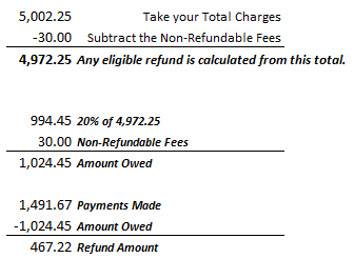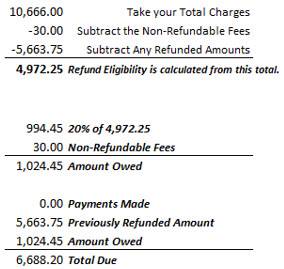Dropping vs Withdrawing
Let us help you consider your options
Submitting an online withdrawal request will only withdraw you to zero hours from the specified semester. This will not interfere with additional semesters you may be registered in. If planning to withdraw from the university, you will need to submit a withdrawal request for each available semester by the deadlines posted on the academic calendar.
You may be considering dropping courses or withdrawing from the university due to academic challenges, illness, family issues, or other personal circumstances. Texas State has resources that can help you stay enrolled or, if need be, learn about what happens when you drop courses or withdraw. We hope our campus resources will help you remain enrolled.
Talk to someone before you drop or withdraw from a semester!
|
If you have... |
Contact these people for help... |
|---|---|
|
Difficulty paying for school |
Student Business Services and Financial Aid can talk to you about options that may be available. |
|
Difficulty managing money |
You can participate in Financial Coaching free of charge. The coaches are AFCPE (Association for Financial Coaching and Planning Education) trained counselors who can provide you with the resources and knowledge to help you reach your money management goals. |
|
Trouble with grades or keeping up with coursework |
Your academic advisor can advise you about options: The Student Learning Assistance Center (SLAC) can help with tutoring and other services. Success Coaching can assist you with individualized strategies and a personal plan to help improve your academics and overall productivity. |
|
Stress or personal issues |
|
|
An emergency (prolonged illness, death in the family, natural disaster or major life event) |
The Dean of Students Office provides consultation services to students in emergency situations. |
Dropping Courses or Withdrawing from a Semester is a Serious Decision
Do you know the differences between dropping and withdrawing?
Withdrawing is going to zero hours for a current or future semester. You may withdraw from the current semester without withdrawing for a future semester. For example, you can withdraw from all classes in summer and stay enrolled for the fall semester.
Dropping means that you will remain enrolled in at least one hour in the current semester. In 2007 the Texas Legislature enacted Senate Bill 1231 which provides that, except for several specific instances of good cause, undergraduate students entering as first time freshmen at a Texas public institution of higher education in the fall of 2007 or later will be limited to a total of six dropped courses during their undergraduate career.
Notification to the instructor does not constitute a drop or withdrawal. If you are considering dropping courses or withdrawing, read through the questions below.
Have you talked with an advisor?
Dropping courses or withdrawing can delay your graduation and your academic progress. It could also hurt your student record. There may be alternatives to dropping or withdrawing, such as taking advantage of academic support services like tutoring. An academic advisor can help you consider your options. If you are considering dropping or withdrawing contact your advisor (Undergraduate Advising, Graduate Advising).
Have you considered the financial impact of withdrawing?
Did you know that you may owe money if you drop or withdraw?
Dropping courses or withdrawing from the University does not relieve a student of their financial obligation to the University for any unpaid charges (including financial aid adjustments) incurred for the related semester or term.
You may not receive a refund and you may owe money.
You should first check the withdrawal refund schedule. If you are past the point of any type of refund, you will owe the full unpaid balance of your tuition & fees. The refund amount is not based on payments made but charges on the account. For example, during the 70% refund period, 70% of the refundable charges would be credited back to the account. This does not necessarily mean that you would get 70% of the amount paid unless you were paid in full.
- An immediate refund will not be made at the time a student withdraws. All refunds will be applied to remaining unpaid obligations, including registration balances for future terms, before funds are returned to the student.
- Housing and meals plans may be prorated and credits applied accordingly, but it will depend upon your taking official steps to complete all necessary paperwork; you must contact the Department of Housing and Residential Life to complete all forms. Additionally, once withdrawn, you generally have only 48 hours until you must be moved out.
- If you received financial aid, VA benefits, scholarships (including Athletic), or other tuition adjustments withdrawing may be result in the loss of part or all of these payments resulting in additional charges owed to the University.
Final adjustments may take several weeks before being applied toward your student account. It is critical that you speak with the corresponding office if you have received any type of payment assistance. Refunds of parking fees must be requested at the Parking Services office. For more information on refunds, read the Refund Information webpage from Student Business Services.
You may owe back financial aid.
If you withdraw on or before the 60% point in the semester or period of enrollment, you will have to pay back some of your financial aid. If you withdraw before the census date (i.e., 12th class day in a long semester), you will have to repay any state grants and possibly some scholarships as well. It’s very important for you to visit with Financial Aid and Scholarships before deciding to withdraw so you understand your repayment obligations.
If you fail to complete all your courses (i.e., receive all U’s, all I’s or a combination of U’s, I’s, or W’s) during a semester, you are considered to have unofficially withdrawn. As a result, you will owe back a portion of your financial aid for that semester. You can find more information at the Financial Aid and Scholarships website.
You may not be eligible for future financial aid.
To remain eligible for financial aid in future semesters, you must be meeting the Satisfactory Academic Progress (SAP) requirements. One of those requirements is to maintain at least a 67% completion rate. This means that you must complete 67% of all courses you attempted on your transcript. Since withdrawn courses are not completed, withdrawing will negatively impact your completion rate and could put your eligibility for financial aid in future semesters at risk.
You will need to repay student loans.
Once you withdraw, your six month grace period will begin for any federal student loans you have borrowed. If you do not re-enroll at least half-time within six months of withdrawing, you will need to begin repaying your student loans. You can find more information about loan repayment at https://studentaid.gov/manage-loans/repayment. You can find out your current loan balance and your servicer information on the NSLDS website.
Sample Calculations
Example 1 – Student withdraws during the 80% Refund Period. No assistance received.

Example 2 – Student withdraws during the 80% Refund Period. Assistance was received with total loss of assistance.

Do you need someone to talk to about stress or personal issues?
College is an exciting time, but it can also be demanding. Students may experience a variety of personal and adjustment issues that require assistance beyond what friends and family can provide. The Dean of Students Office provides consultation services to help students in emergency situations, understand University policy related to leaving courses, and general support.
Counseling Center services are free, confidential, and provided by trained professionals to currently enrolled Texas State students while classes are in session. Some common concerns addressed in counseling include stress/anxiety, low self-esteem, relationship challenges, depression, academic performance, and substance use.
If you live in on-campus housing, your Residence Director may provide additional information on various resources across the campus available to assist you in making a good decision concerning your withdrawal.
Are you a graduate student?
First and foremost, it is recommended that you discuss your situation with your graduate advisor if you are considering withdrawing. Please consider that there may be continuous enrollment requirements specific to your program of study that can jeopardize your status. Regardless of your program’s enrollment requirement, if you do not enroll for four consecutive terms, you must submit a new application for admission should you wish to return. More details regarding this process can be found here.
If you feel that outside circumstances will negatively impact your studies, an approved Leave of Absence will preserve your status in your degree program and streamline the process for continuing your studies once you return. (Note: Even if your Leave of Absence form is approved, you will still have to submit a new application if you do not attend within four consecutive terms.) A Leave of Absence cannot be approved retroactively or for a semester that has already begun, so make sure to discuss this process with your advisor if you are considering this option. For more information regarding the Leave of Absence policy and process, please view the Graduate Catalog. Finally, dropping or withdrawing can impact your ability to retain your awarded scholarships and assistantships. Please review the Scholarship and Fellowship policies and the information regarding Graduate Assistantship.
Again, please contact your graduate advisor as well as The Graduate College if you need further clarification. The Graduate College is located in Suite 280 of the J.C. Kellam Administration Building. We can be reached by email at gradcollege@txstate.edu or by phone at 512-245-2581.
Are you an international student, student athlete, or receiving veteran's benefits?
International Students
For international students in F-1 or J-1 status, withdrawing from the university can affect your legal status in the United States. Please contact International Student and Scholar Services (ISSS) at 512-245-7966 or international@txstate.edu for advisement before proceeding further.
Student Athletes
Withdrawing from the university may have an impact on your athletics aid and your eligibility. Please contact the Athletics Compliance Office at 512-245-2114 or athleticscompliance@txstate.edu before taking any steps to withdraw from the university.
Receiving Veteran's Benefits
The number of credits you take will impact your benefit eligibility, cost of attendance, and student status. Contact the Office of Veterans Affairs before and after you change your schedule so that you understand how it might affect your benefit status.
- Hazelwood users may have the hours attempted counted towards their overall limit, even if you withdraw.
- GI Bill® users are charged use by day of school, as the VBA does not adhere to any school refund schedule.
- You must provide documentation to the Office of Veterans Affairs prior to withdrawing if you wish to have mitigating circumstances applied.
Do you live in campus housing?
If you have a contract to reside in on-campus housing, you will need to complete a housing cancellation form as soon as you have withdrawn from classes. You may owe money or you may have a refund, depending on several factors. It is also important to note that you have only 48 hours after your withdrawal to move out of your assigned campus housing space. In some limited cases, students may petition the Director of Housing for approval to remain in their assigned space. For specific information related to your housing status and withdrawal, please visit the Department of Housing and Residential Life.
Are you ready to drop or withdraw from a semester?
Be sure you have explored all of your options before you decide to drop or withdraw. Dropping and withdrawing can have serious consequences for both your finances and your academic progress.
Drop a Single Class
To drop a class, log on to Registration/Schedule Changes from Texas State Self-Service. As a reminder, dropping is removing one or more classes from your schedule, but having at least one class left.
Please note:
-
You can check the final Drop deadline on the academic calendar.
-
Drop refund deadline information can be found on the Student Business Services Withdrawal/Drop Refund web page, or contact Student Business Services at (512) 245-2544.
-
Having trouble? Watch a video on How to Register/Drop a Class.
Withdraw From All Classes for a Semester
To withdraw from all classes, submit the Online University Withdrawal form. As a reminder, withdrawing is dropping all of your classes in a semester (going down to 0 hours).
Please note:
-
You can check the final Withdrawal deadline on the academic calendar.
-
Withdrawal refund deadline information can be found on the Student Business Services Withdrawal/Drop Refund web page, or contact Student Business Services at (512) 245-2544.
